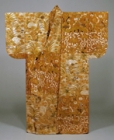Japanese Gallery (Honkan) Room 9
September 23, 2008 (Tue) - November 9, 2008 (Sun)
The Noh costume style we know today was completed in the mid-Edo Period (1603-1868). Karaori, woven using many gold threads and decorated with designs woven in colorful additional threads, were used mainly as outer garments for female roles. Kariginu and happi with substantial design motifs woven in gold threads were suitable for roles of higher positions such as demon-gods and emperors. The creation of such gorgeous styles as these were possible only because of the highly advanced weaving techniques which rapidly developed in Japan from the Edo period, and because of the patronage of feudal lords who spent their fortune unsparingly for the Noh theatrical art.
Noh performances were popularly held by samurai and at temples and shrines from the Muromachi Period (1392-1573). Although it declined after the Onin civil war (1467-77), Noh became popular again in the Azuchi-Momoyama period (1573-1603), mainly among samurai. The fact that Toyotomi Hideyoshi (1537-1598), who first unified Japan after the Muromachi government lost control, was a great lover of Noh led to Noh costumes becoming light and colorful, reflecting the trends of Hideyoshi's time. Japan was far behind China in weaving techniques at that time, and it took a long time to produce karaori. Karaori outer garments seem to have been very precious and hard to obtain. As their substitute, nuihaku, richly decorated with embroidery and imprinted gold leaf (surihaku), were used as outer garments.
Kariginu and happi for noble roles were made of odon (gold brocade woven with vertical silk threads and horizontal cotton threads), gold and silver brocade imported from China. Costumes made of ramie, including hitatare and suo, featured stencil-dyed designs which are plain and free from the traditional style. They show an elegant simplicity indigenous to Noh, unlike the gorgeous theatrical designs of today.
This exhibition is centered around three main collections: those costumes preserved by the Konparuza troupe in Nara, a city located in the area where Noh first emerged; those formerly owned by the Mori family, recorded as having been used by the head of the family when he performed in front of Hideyoshi; and the collection of Azuchi-Momoyama period Noh costumes owned and preserved by the Kasuga Jinja shrine in Seki-shi, Gifu.

